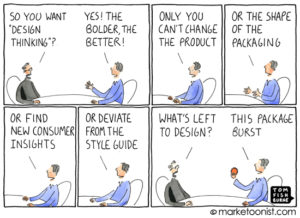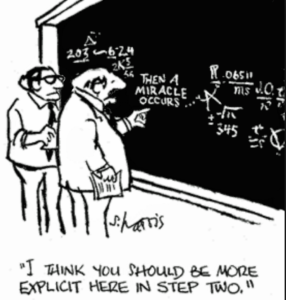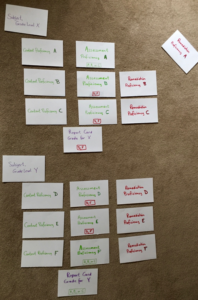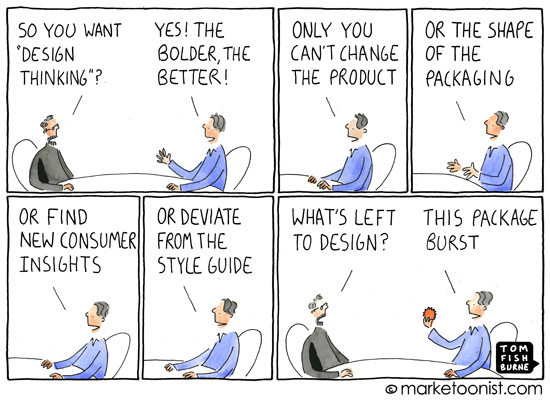Collision happens, of course, with the good energy of ramped up design thinking. Organizational structure still widely favors the Industrial Revolution approach, and educational institutions are rarely an exception; that is, the traditional concept of leadership is characterized by the (white) man at the top of the hierarchy with voiceless compliant people at the bottom. But design thinking manifests a positive and important paradigm shift in leadership for change in our transformative times. By its very nature design thinking em ploys lateral, collaborative initiative based on the understanding that everyone acts from a point of personal leadership. The collision happens when these two frameworks of organization and development meet each other.
ploys lateral, collaborative initiative based on the understanding that everyone acts from a point of personal leadership. The collision happens when these two frameworks of organization and development meet each other.
As part of the SpacelLab Design Network of the Colorado Education Initiative I set out to explore alternatives to the grade level structure that is still common in many of our public and private schools. I started with this problem statement: The traditional grade level structure in P-12 schools exacerbates deficit approaches for many students’ achievement of expected proficiencies. The notion is that grade levels inevitably lead to a deficit model of remediation, observing that all students do not travel in the same way and in the same pace from the beginning of a grade to the end. However, the expectation in a traditional grade structure is that they will, or should. If students don’t achieve the expected proficiencies by the end of a grade level, or even at points during the grade level, tremendous energy goes to remediation strategies and programs to catch students up to where they “should be.” Complicated logistics to feather remediation into the instituted marching time frame of learning, both within a grade and from grade to grade, must be constructed to keep remediating students on track while at the same time recovering from fundamentals required for that on-pace learning. This is the point where a miracle is expected to make this conundrum  work. Furthermore, students enter the beginning of a grade with a wide range of backgrounds and assets for academic encouragement, support, momentum, language, and cultural compatibility to both the school context in general, and the specific knowledge content being taught. Many assets kids have are not recognized as such, or in fact not recognized at all, given the typical dominant culture, structure, and organization of the school. Also, as most kids know, from student to student there is an uneven readiness across disciplines at any given grade level for the content and skills presented. For example, one student might have excellent number sense either from family and culturally based number orientation, but have a distant orientation to the schools’ approach to literacy for that grade level. The bottom line is that the students who most need an asset based approach to learning and matriculating to new learning are the least likely to benefit from the externalized catch-up pressure.
work. Furthermore, students enter the beginning of a grade with a wide range of backgrounds and assets for academic encouragement, support, momentum, language, and cultural compatibility to both the school context in general, and the specific knowledge content being taught. Many assets kids have are not recognized as such, or in fact not recognized at all, given the typical dominant culture, structure, and organization of the school. Also, as most kids know, from student to student there is an uneven readiness across disciplines at any given grade level for the content and skills presented. For example, one student might have excellent number sense either from family and culturally based number orientation, but have a distant orientation to the schools’ approach to literacy for that grade level. The bottom line is that the students who most need an asset based approach to learning and matriculating to new learning are the least likely to benefit from the externalized catch-up pressure.
As a school designer, I have tremendous interest in exploring ways for students to move ahead in school through a more natural and internalized learning process where they own what they are learning through authentic and meaningful experiences they can relate to. I am passionate about equity and access in the learning process, and I see corners of our conventional education system that impedes this equity and access through well-intentioned reform and remedy strategies that continue to be built on old assumptions. I see grade level structure as one of these old assumptions. The SpaceLab Design Network experience has given me a chance to explore this line of thinking.
For my exploratory/research phase I interviewed a broad representation of educators and students to reflect on this topic. These included students in different grade levels, teachers of various subjects, and administrators from several levels in a district hierarchy. I used a deck of cards to demonstrate a process about how students’ lack of proficiencies accumulates, even struggling through remediation. Everyone I talk with expressed an understanding of  this problem as common knowledge. I then asked each person to tell me how a student in remediation as a result of unmet proficiencies within the school system’s time and pace expectation would feel as she/he falls further and further behind. The unanimous response was that the student would feel increasingly insecure and unmotivated, eventually to the point of dropping out of school. I asked each person to think creatively about how to prevent this accumulating lack of proficiencies. Everyone talked about the importance of remediation of some sort. Some talked about catch up programs, including online programs like Apex or Khan Academy, where a student could catch up, either during a given course, or gain credit for a failed course after that the course was over. A few, including a student, talked about online resources that students should be informed about which would help them to keep up or catch up. One administrator talked about time flexibility within grade levels that would allow students to retake portions of a course and retake tests. No one, however, brought up a challenge to the grade level structure.
this problem as common knowledge. I then asked each person to tell me how a student in remediation as a result of unmet proficiencies within the school system’s time and pace expectation would feel as she/he falls further and further behind. The unanimous response was that the student would feel increasingly insecure and unmotivated, eventually to the point of dropping out of school. I asked each person to think creatively about how to prevent this accumulating lack of proficiencies. Everyone talked about the importance of remediation of some sort. Some talked about catch up programs, including online programs like Apex or Khan Academy, where a student could catch up, either during a given course, or gain credit for a failed course after that the course was over. A few, including a student, talked about online resources that students should be informed about which would help them to keep up or catch up. One administrator talked about time flexibility within grade levels that would allow students to retake portions of a course and retake tests. No one, however, brought up a challenge to the grade level structure.
When I asked my research interviewees what they thought about disturbing the grade level structure and about only matriculating students based on achieved proficiencies, all but a couple in this group listened with curiosity. However, only two students and one administrator extended the conversation in consideration of a structure not founded on grade levels. All others, however, settled mostly on a “can’t do it” reaction to an alternate structure. For example, administrators referenced the challenge this option posed for other structures in place related to grade level pacing, such as “on time to graduate.” And teachers expressed concern about how this would complicate their teaching, and had pictures in their mind of how their role as teachers would change and become even more onerous than it is now. There were a range of other pushbacks from this group as well.
My next step in this process is to gather together a group like that of my interviewees for a collaborative design process to see if it can create a framework to share beyond the group for consideration. The edge for this process is to make sure that the group is diverse like the first group was in age, role, background, and starting point regarding the concept. The reason this is the edge is because too often design thinking around change proposals happens in a siloed environment where participants start out with a more common starting point. I’m looking forward to this to see how such a process can actually evolve into a viable and important change that speaks to the achievement gap that has otherwise been so intractable.
Some people in education, both consumers and producers, are eager to think creatively and collaboratively in creating deep, directed changes that yield more effective, asset-based learning logistics and infrastructure. There are districts, including one I know very well, that have entire departments dedicated to such needed changes. The challenge is when strategies that emerge from these departments confront the more traditional operations side of the institution. Collision happens. At this intersection,  accessible and valuable sea changes that are entirely couched in asset frameworks experience a snap backwards to mere tweaks. As a result, needed education modifications for our time of exponentially accelerating technological and societal changes cannot keep pace. This is the challenge of our time: creation of viable improvements through true diverse collaborations, with the will, patience, and integrity of well-facilitated design thinking.
accessible and valuable sea changes that are entirely couched in asset frameworks experience a snap backwards to mere tweaks. As a result, needed education modifications for our time of exponentially accelerating technological and societal changes cannot keep pace. This is the challenge of our time: creation of viable improvements through true diverse collaborations, with the will, patience, and integrity of well-facilitated design thinking.

